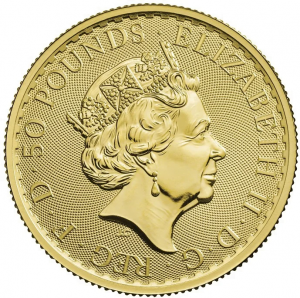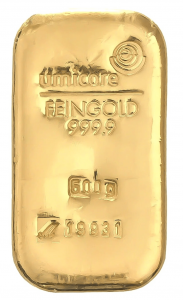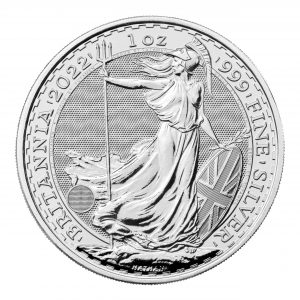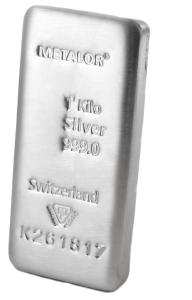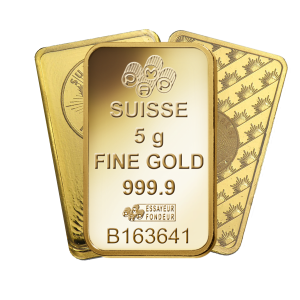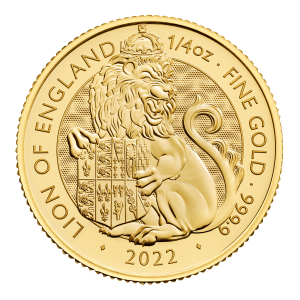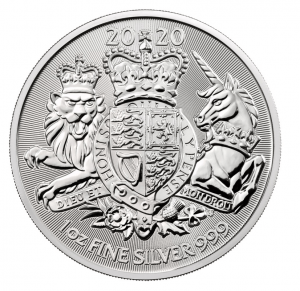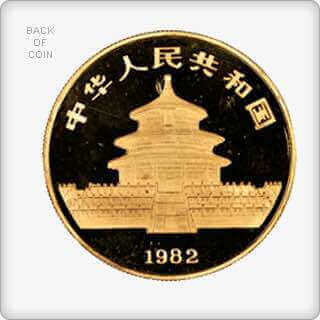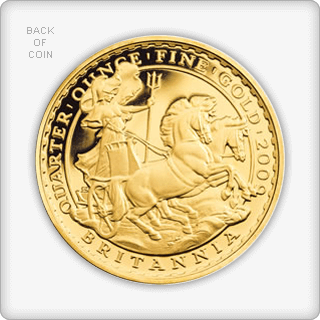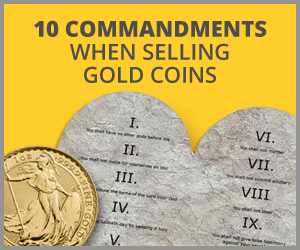Best UK gold coins ever
British gold coins have always been a great investment as they have a long history of coinage. These coins are an incredible asset to any numismatist and almost always appreciate in value over the years. Although many were issued over the years, they continue to remain a much-sought-after category of coins across the world for both investors and collectors alike. In this article, we will explore ten of the best British gold coins that have consistently delivered great value to buyers worldwide.
1) George V gold sovereign
The sovereign has a long history, having originally been issued by Henry VII in 1489. The sovereign issued in those years had a diameter of 42mm and weighed 15.55gms. It was initially known as the “double royal” but soon had its name changed to the sovereign. It is thought that at the time, it was too great in value to enjoy circulation, and was retained as a presentation piece for important delegates. The sovereign enjoyed resurrection in later years and in 1871, it was restored by Sir Charles Fremantle, the deputy minister of the Mint at the time. Sir Charles used a design by Benedetto Pistrucci, the Italian designer who passed away in 1855, known as the George and the dragon.
Approval from the Queen
The design was approved by the Queen and was used to strike sovereigns from 1871 to 1874 in Britain. The sovereign featured the head of the reigning monarch. In 1910, after the death of Edward VII necessitated a new obverse of his son, King George V, the design of which was created by designer Bertram Mackennal. This version of the sovereign continued to feature Pistrucci’s design of St George and the dragon on the reverse. It had a nominal value of one pound and is now considered to be a valuable bullion coin that is bought by investors, as well as numismatists as a collector’s item. George V gold sovereigns are available from Physical gold for as little as £390.
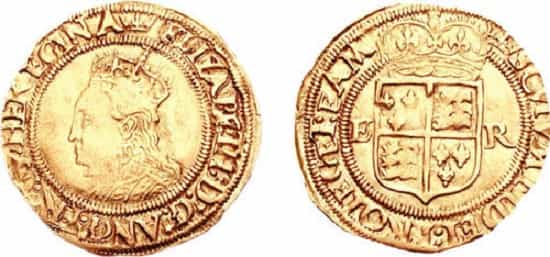
The gold crown from the Elizabethan era is a valuable collector’s item today
Download our FREE 10 step cheat sheet to obtaining the best selling price for your gold coins here
2) King Edward VII sovereign
The tradition of the sovereigns was of course preceded by King George V’s father, King Edward VII. Edward was the eldest son of Queen Victoria, who was often referred to as the greatest British monarch. He acceded to the throne upon his mother’s death in 1901 at the age of 60. The sovereigns issued upon the monarch’s accession to the throne commenced in 1902. These coins featured an obverse designed by George William De Saulles. These gold coins were issued until he died in 1910. You can purchase these for your collection from Physical Gold.
3) Queen Victoria sovereign (young head)
Three sovereigns were issued during the reign of Queen Victoria. These coins featured a ‘young head’, ‘jubilee head’ and an ‘old head’ on the obverse. Of course, the ‘old head’ was coined during the later years of the reign of the Queen. The ‘young head’ coins display the Queen in a youthful look. Interestingly, there are two types of obverse sides for these coins. The St. George and dragon is one of the popular issues for the obverse side, however, a rarer and more valuable obverse features a shield back design. Queen Victoria sovereigns were struck at mintage quantities of more than 16mn by 1872. The coins you purchase from Physical Gold will most likely have a St. George and dragon motif on the obverse and would date between 1871 and 1887, but we do sometimes get lucky with the odd Victoria shield back Sovereign.
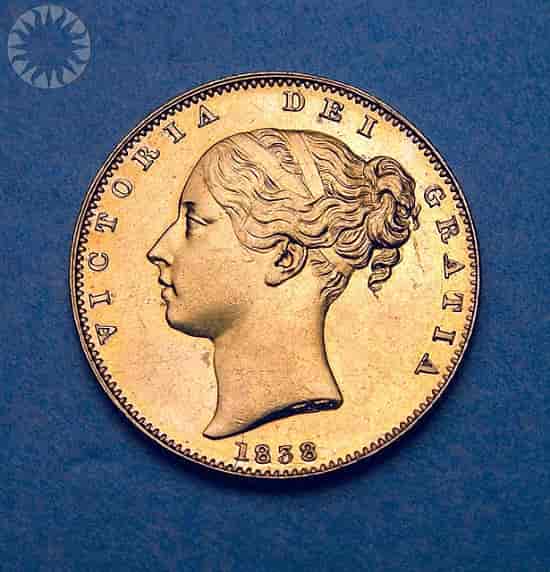
The Queen Victoria gold sovereign with the young head is an iconic British coin. This one displays a mintmark dating back to 1838
4) Gold Britannia 30th anniversary edition 1oz
The Gold Britannia is a bullion coin produced by the Royal Mint. 
5) Half sovereign gold coins
Half sovereigns are an excellent buy, probably second only to the gold sovereign itself. Half sovereigns were issued as a part of the great British coinage with the obverse featuring different monarchs, during their respective reigns. These include Queen Elizabeth, the reigning monarch, as well as George V, Edward VII and Queen Victoria. Most of the coins available today are pre-owned and can be purchased from Physical Gold for as little as £195.
6) Queen Victoria Jubilee head sovereign
The sovereign coins featuring the Queen Victoria Jubilee head were minted for only 7 years in limited numbers and are therefore lesser in number and rarer. These coins have mintmarks indicating that they were struck in mints across the erstwhile British Empire, namely London, Melbourne, and Sydney. Select coins are available as tax-free investment from Physical Gold.
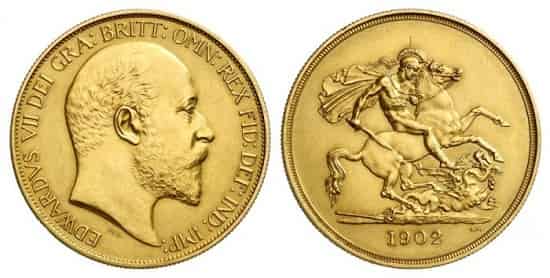
A popular theme of British coinage is to feature an image of St. George and the dragon on the obverse and the monarch’s head on the reverse.
7) The English ‘angel’ gold coin
The angel is considered to be an iconic British gold coin, so famous at one time that the name was used to christen places and venues. The famous ‘Angel Inn’ in Islington, London is named after it, as is the Angel tube station in London. The coin was initially introduced by Edward IV in 1465. The obverse featured an image of the archangel Michael slaying a dragon, while the reverse shows a ship with arms, with sun rays at the masthead. The angel was continued as a part of British coinage through the reign of many monarchs, including Henry VIII, Elizabeth I, James I and Edward VI and had different values from 6 shillings to 11 shillings. Today it is a valuable and rare collector’s item. A gold angel from the reign of Elizabeth I is valued at £7,250 by Stanley Gibbons.
8) Elizabeth I gold crowns
Queen Elizabeth, I had a substantial gold coinage, although much underrated by numismatists. The gold crowns issued during the Elizabethan era were meant for circulation only in 1601 and 1602. These coins are a great collector’s item today, as limited quantities were minted at the time. The obverse features the Queen’s head, while the reverse displays the royal coat of arms.
9) Queen’s beasts gold coins
Although a relatively new addition to British coinage history, the series has had a significant impact on buyers and is certainly worthy of mention. The royal mint introduced these in 2016 and the iconic coins form a series, with each coin featuring one of the ten queen’s beast statues that were displayed at the coronation of Queen Elizabeth II, the current reigning monarch.
10) Lunar gold coins
Lunar gold coins were issued by the royal mint from 2014. It is a series of bullion coins, with a new coin launched each year, featuring a Chinese zodiac animal associated with that particular lunar year. The entire series will be a 12 coin series and the ones already released feature the dog, monkey, sheep, horse, and rooster. You can view these and purchase the ones you love at Physical Gold. Interestingly, in 2014 it was reported that 38,000 coins had been mistakenly struck with the obverse intended for the gold Britannia. These coins would eventually become a rarity and a collector’s item due to the error.
Talk to us for the right guidance on buying British gold coins
If you’re thinking of investing in British gold coins as an investor or a numismatist, look no further. Our team at Physical Gold has both silver and gold investment experts as well as numismatics experts. Call us now on 020 7060 9992 or contact us via our website for guidance on buying gold coins.
Image credits: Wikimedia Commons, Public Resource.org and Wikimedia Commons
The Britannia is one of the most famous coins ever released in British coinage history. It is the pride and joy of the Royal Mint and also forms the backbone of any precious metal coin portfolio. The Britannia is available in both gold and silver and offers tremendous liquidity to the portfolio of an investor. Due to its reputation as one of the best-known coins in the world, it is easily saleable for cash.
The Britannia coin
The Britannia gold coin is a 1-ounce coin with a purity of 999.9 and a face value of 100 GBP that was launched by the Royal Mint in 1987. It is available in bullion and proof finishes, as well as fractional sizes. The Royal Mint also introduced a silver Britannia coin in 1997, which has a face value of 2 pounds. The silver Britannia contains one Troy ounce of fine silver. Both the gold and the silver coin feature a portrait of the reigning British monarch, Queen, Elizabeth II on the obverse of the coin. The reverse of the coin features the classic image of Britannia. The event featured on the coins issued from 1987, was designed by Philip Nathan. In 2018, the Royal Mint also released a Platinum version of the Britannia coin that contains one Troy ounce of Platinum and has a face value of £100.
The iconic image of Britannia above Somerset House in London
Who was Britannia?
In 43AD Britannia meant Roman Britain. This was an area to the south of what is known today as Scotland. In 197AD Roman Britain was divided into 4 provinces and 2 of these were Britannia Superior and Britannia Inferior. Britannia was the name given to this Island. In the 2nd Century, Roman Britannia was what is recognised today as the goddess armed with a trident and shield. Britannia was featured on all modern British coinage until being redesigned in 2008.
The Romans used the term ‘Britannicae’ to refer to the British Isles. The inhabitants of Britain were called ‘Britons’ at the time. Another name for the people of the British Isles used by the Romans was ‘Britanni’. Since the British Isles represented the furthest territory of the Roman Empire, it became symbolised with the goddess of warfare and water. Roman mythology portrays a goddess called Minerva, who is popularly known as the torchbearer of arts, commerce, strategy and wisdom. The image of Britannia was based on the icon of goddess Minerva and came to personify the British Isles over the years.

A World War 1 Poster depicting Britannia
Reinforcement of the Britannia image
After the invasion of England by the Anglo-Saxons, the ethnicity of the country changed drastically, with the exodus of the original Celtic Britons. However, years later, as Queen Elizabeth, I combined England, Scotland, Ireland. and Wales and significantly increased the nation’s naval power, the image of Britannia was restored as a representation of the nation’s power and the Queen. This was further reinforced during the reign of the great Queen Victoria when the British Empire became the most powerful empire in the world and Britannia ruled the waves. The iconic image of Britannia was then put firmly in place to represent the power of the British Empire, and its monarch.
Physical Gold can assist you in purchasing Britannia coins
Whether it’s gold Britannias or silver ones that you’re after, our coin experts at Physical Gold can advise you on how to get the best deals. Call us on (020) 7060 9992 or drop us an email and a member of our team will reach out to you at the earliest.
Image credits: Alastair Rae and Picryl
The Panda coin
Country: China
Face Value: 100 Yuan
Gold Content: 1 ounce (31.103g)
Purity: 99.99% (24 karat)
Gross Weight: 31.1036g
Coin Diameter: 32.103mm
First year of issue: 1982
The Chinese Panda coin is a series of gold bullion coins issued by the People’s Republic of China. This coin is 24 karat gold and has a face value of 100 Yuan. The mint introduced the Panda gold bullion coins in 1982. Each year of production, other than 2002, the reverse design of the panda coin has changed and has therefore enabled the Chinese to build a steady demand regardless of gold price fluctuations.
Over the last 30 years, Gold Panda Coins have become an established favourite with many collectors, who appreciate their stunning and unusual designs, as well as the coin’s highly distinctive colouring. The coin itself is backed by the Chinese Government which means it has a guaranteed purity level much like the UK Britannia coin or the South African Krugerrand.
Proven techniques to sell your gold coins at the highest price. Download FREE
Mintmarks
One area where Panda Coins differ to other bullion coins is that they don’t contain any mintmarks to show the place where they have been produced. Pandas are produced in a number of different Chinese mints including Beijing, Shanghai, and Shenyang. In order to determine the mint, you need to take a careful look at variations between coins such as the colour of the metal or subtle design differences.
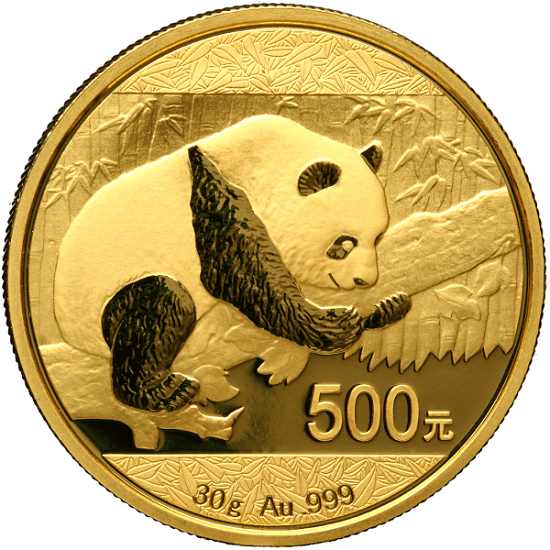
2016 Chinese Panda coin
Currently, all Gold Panda Coins have a purity of 99.99, making them an ideal option for gold bullion investors. They are also available in a wide range of different denominations, depending on your investment requirements. Up until 2016, the gold Panda was produced in denominations ranging from 1oz to 1/20oz.
Now in metric…
This has now changed, however, and Panda Coins are currently being minted in metric system sizes instead. The reason for this change is purely down to the coins growing popularity with international investors. With many countries replacing the old troy ounce system with modern metrics, the People’s Republic of China felt they could capitalize on the coin’s widespread appeal by following suit. The new and updated coin sizes can be seen below:
- 1 oz coin is now 30 grams
- 1/2 oz coin is now 15 grams
- 1/4 oz coin is now 8 grams
- 1/10 oz coin is now 3 grams and
- 1/20 oz coin is now 1 gram
Since 1983 the Panda Coin has also been available in silver. Like the Gold Panda, the Silver Panda Coin’s design changes every year making them very collectable among investors.
The growing appeal of Panda Coins
Many astute investors believe Panda premiums could rise significantly over the coming years due to growing demand linked into China’s rise as an economic powerhouse. With their modest premiums, these coins can offer a viable bullion alternative. There is also a vast natural market for Panda Coins due to the growing amount of expatriate Chinese ethnics.
The obverse features the Temple of Heaven with Chinese characters on top saying “Zhonghua Renmin Gongheguo” meaning the People’s Republic of China. If the issue is a commemorative issue of the Chinese Panda coin, the theme will be marked below.
Variety….
The Reverse shows different portraits of pandas that change every year, other than the one exception in 2002.
Whilst the value of gold and silver has been in continual fluctuation over the past few years, the value of Panda Coins has continually increased, and the market shows no signs of slowing down. Currently, Panda Coins are growing in value at a much higher rate than other bullion coins. This is partly due to the fact that they are comparatively relatively scarce, and also because they are only produced in fairly small mintages.
Image Credit: Wikipedia
Britannia coins are the one-ounce British Bullion coins issued by the Royal Mint since 1987. Both proof and bullion versions have been issued every year to date and fractional versions are commonly available. The Britannia coin is available in either silver or gold and since 2013 has a purity value of 999.9. It is currently the largest, purest British legal tender coin available on the market.
Britannia coin
County: Great Britain
Face Value: £100 GBP
Gold Content: 1 ounce (31.104g) – Alloyed with copper or silver depending on year (pure from 2013)
Purity: 917 / 1000 (22 karat) (1987-2012) or 999.9/1000 (24 karat) (2013-)
Gross Weight: 34.0500 g (1987-2012) or 31.104g (2013-)
Coin Diameter: 32.69 mm (1987-2012) or 38.61mm (2013-)
First Year of issue: 1987
British coinage history
Britain has a long history of coinage. The first coins that were minted in Britain were Celtic ones around 80 BC. The first gold coins and silver coins in Britain were introduced by the Romans. The gold one was called ‘Aureus’ and the silver ‘Denarius’.
Sell your Gold Britannias at the highest possible price. Find out how with our 10 simple rules
Why Britannia?
The ‘Britannia’ first appeared on the coins of the Roman Emperor Hadrian in AD119. 
Bullion coin market growth
After the 80s saw significant growth in the global bullion market, the Royal Mint introduced Britannia coins to their bullion portfolio. Designed by Philip Nathan, the coin featured a new interpretation of Britannia that was powerful, yet elegant and it caught the imagination of the entire nation. Introduced in 1987, the coin made a worldwide impact and became a classic. Today, 30 years later, the classic design still remains the same – with a small addition. The new design displays a radial sunburst on her back.
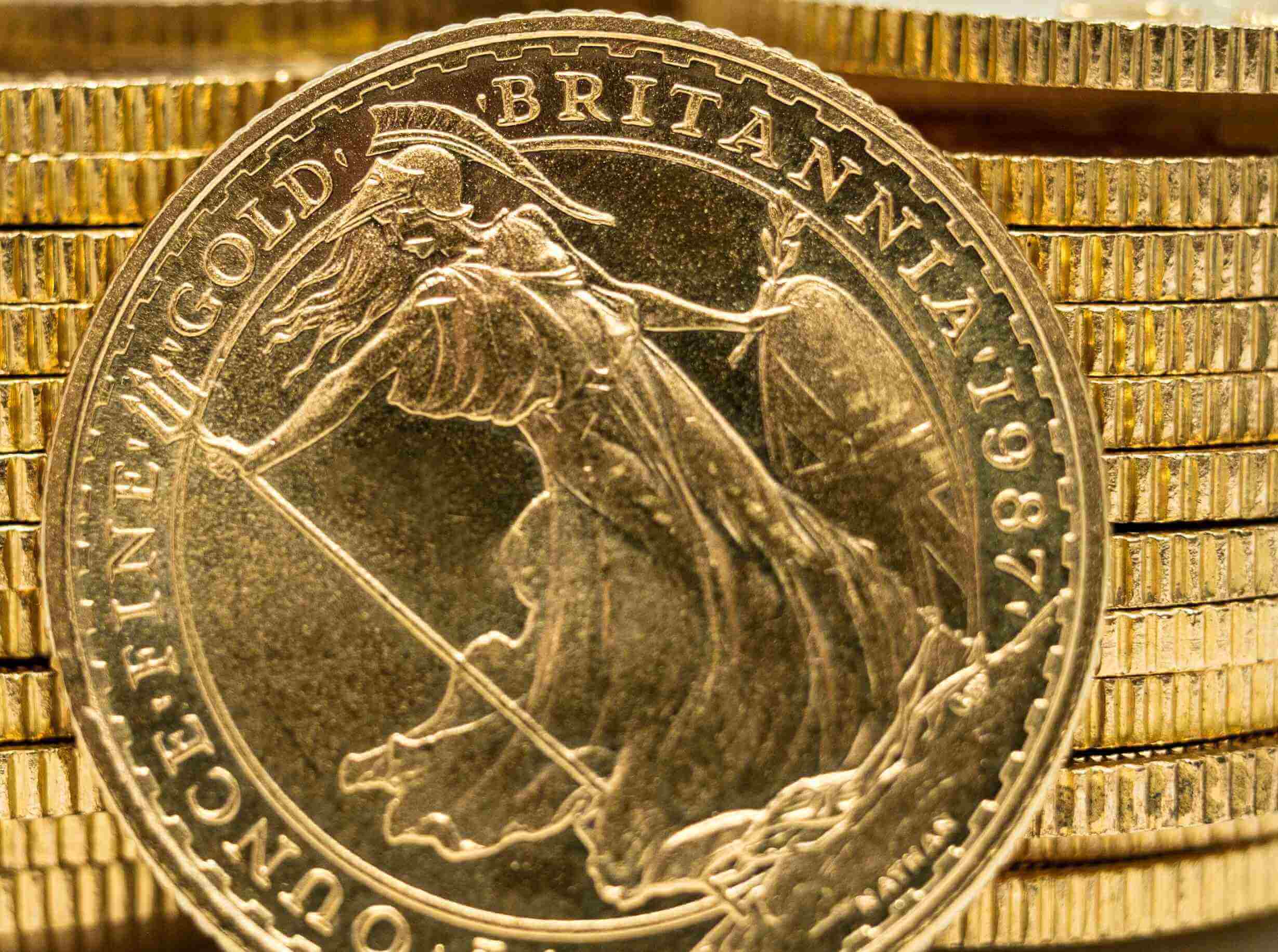
The beautifully designed Gold Britannia
The Britannia – Europe’s premier modern coin
The Britannia coin is fast becoming Europe’s premier modern coin and is regarded as one of the world’s most beautiful coins. This coin is admired by collectors, dealers and investors from around the world, and is, therefore, one of the World’s most liquid coins.
With the face value of £100 UK Britannia coin is considered legal tender in Great Britain and it is therefore not subject to Capital Gains Tax when sold for a profit by UK residents. As the law currently stands you are required to pay CGT for any personal goods you have sold or made a profit on over the tax-free allowance rate of £11,300. As gold and silver Britannia’s are CGT exempt, however, you can sell as many as you want over the tax year without having to pay CGT.
Design features
The classic design featured on the 2018 1oz Britannia coin
displays a stroking image of a standing Britannia who is portrayed as a beautiful young woman, wearing a centurion’s helmet and holding her trident aloft. The reverse side of the coin features the most recent portrait of Queen Elizabeth II which was designed by Jody Clark of the Royal Mint and first introduced in 2015. Like previous editions of the Britannia coin, it has a purity of 999.9 and is created in 24 karat gold.
Britannia gold coins originally had a fineness of 91.7% or (22 karats) gold with the alloy being copper until 1989 and silver from 1990. The Royal Mint increased purity to 24 karats from 2013 to appeal to the ever-growing Asian market.
Collectable and with solid investment potential
These lovely 24 karat coins are an amazing investment for any numismatist or an investor. They are worth their weight in gold and have a purity of 999.9 since 2013. The 2018 edition is an excellent value for money and fitting addition to any coin collection. Investors on the other hand, who want to invest serious money in these coins as an investment in gold, would benefit from purchasing a large number of the coins. This is because it works out considerably cheaper to buy gold bullion in bulk rather than individual coins. The advantage of purchasing gold in small denominations such as a coin also gives the investor an advantage in terms of liquidity. At a later point in time, when the investor wishes to exit gold as an investment strategy, he need not dilute all his investments. He can simply sell the ones he wishes to and transfers a part of that investment to another asset class.
Britannia coins are also currently available in a range of different weights and denominations depending on the amount you wish to invest. These include 1/2, 1/4 and 1/10th troy ounce coins which have face values of £50, £25, and £10 respectively. Since 2013 two additional sizes of Britannia coin have been introduced – a 5-ounce coin and 1/20th ounce-coin. These have face values of £500 and £5.
Another reason to invest in Britannia Coins is that they present European and UK investors with the opportunity to purchase physical gold totally exempt from VAT. All of our Britannia coins are available to purchase VAT free and CGT exempt.
The Britannia is a prestigious coin, famous all over the world and makes an excellent companion to gold sovereign coins. It would make an excellent Christmas gift item for someone in the family or a loved one. So, as we can see, investing in a Britannia isn’t just about parking money and hedging risks. The coin is a true work of art and would make a fitting family heirloom to be passed down from one generation to the other. The coins come with their own case and are suitable for display as an outstanding work of art and a great symbol of British history. Call us on 020 7060 9992 to discuss how Physical Gold Limited may help you invest in the Britannia 2017.
1983 was an important year for British coinage. It was the year in which the British pound coin was minted and put into circulation to replace the Bank of England’s one pound note. The pound note saw its last issue at the end of 1984. The note continued to be in circulation until 11th of March 1988. On that date, it was removed from circulation.
Like all other UK banknotes, the pound note remained redeemable at the bank. But, for all official purposes, the pound note had been terminated and replaced with the British pound coin. Interestingly, the Royal Bank of Scotland continued the issue of pound notes. Similarly, the Channel Islands continued to use them as well. But the pound coin gained popularity and eventually became the more widely used form of currency. In this article, we will overview the history of the British pound coin.
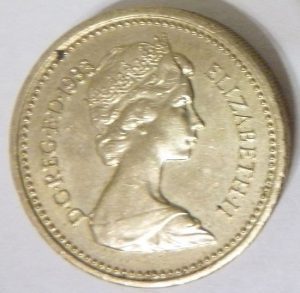
1983 one pound coin with the Queen wearing a tiara
The purpose of issuing a pound coin
The main reason for the withdrawal of the 1 pound note was its longevity. The British one pound banknote survived in circulation for approximately 9 months only. The Royal Mint found out that after repeated usage, the pound notes would often end up being damaged, or defaced. A pound coin, on the other hand, could remain in circulation for 40 years or more. Therefore, on 31 July 1981, the government announced its intention to replace the one pound note with the one pound coin.
The design of the pound coin
The obverse of the pound coin bears a Latin inscription engraved on it. This inscription reads ‘Elizabeth II D G REG’. The abbreviation stands for the words “Dei Gratia Regina”. The entire inscription, when translated into English means “Elizabeth II, by the Grace of God, Queen and Defender of the Faith”. Since the original release of the pound coin on 21 April 1983, four portraits of the Queen, each different from the other, have been used. The year of the mintage was also engraved alongside the Latin inscription.
Discover the 7 crucial considerations before you buy gold coins. FREE download – click here
The first series of coins released in 1983 used a portrait of Queen Elizabeth the second, which had been created by designer Arnold Machin. This portrait appears on the obverse of the coin and features the Queen wearing a tiara. By 1985, a new portrait of the Queen was used, and it was created by Raphael Maklouf. In this portrait, the Queen is featured wearing the George IV State Diadem. This version of the pound coin was issued till 1997.
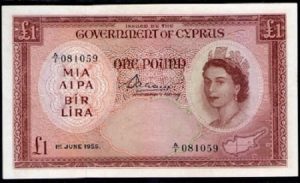
A one-pound banknote from Cyprus – 1955
The changing face of the pound coin
From 1998 to 2015, the design of the pound coin was changed yet again. This time, a new portrait created by Ian Rank-Broadley was used. Once again, the Queen’s portrait depicted her wearing a tiara. A makeover of the pound coin took place again in 2015. This time, well-known designer Jody Clark was commissioned to create the design. Her portrait of the Queen was introduced on the pound coin in 2015 and depicts the monarch wearing the George IV State Diadem.
The reverse of the pound coin had its design changed every year since 1983. This was done to ensure the complete representation of England, Scotland, Wales and Northern Ireland, as parts of the UK. Each year, the one pound coin would have a different emblem which represents each geographic area along with an inscription on the edge. The words, “one pound” can be found on the reverse of all these coins.
The new pound coin 2017
The new one pound coin has a 12 sided, bimetallic structure. This coin was released on 28 March 2017. A design competition was organised with participation from members of the public. This competition was unveiled in 2014 and the results, which were declared in March 2015 named a 15-year-old boy called David Pearce as the winner. The new design featured a rose, thistle, leek and a shamrock, ensconced by a crown.
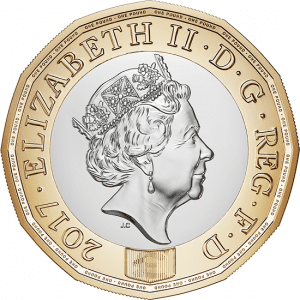
The 12-sided one pound coin was introduced in 2017
Counterfeit coins
Unknown to many, as the round one pound coin gained popularity, counterfeiters took to duplicating this coin. By 2013, there was an estimated 3.04% of counterfeit coins in circulation. The geographical areas that had the maximum number of counterfeit coins were Northern Ireland, the South-East of England and the City of London. Coin testing companies were commissioned by the Royal Mint to study the problem. The coin testing professionals found out that the actual number was approximately twice that estimated by the Royal Mint.
Many times banks did not check the coins they are receiving. As a result, many banks were also inundated with counterfeit currency. The experts detected that many counterfeit coins had poor quality, along with marked visual differences in design. Of course, there were more sophisticated counterfeiters, that would require a specialised machine to detect.
The end of the round pound
The last batch of the British round one pound coins was minted in December 2015. The 12 edge coin that has replaced it is a bi-metallic coin whose design makes it harder to duplicate. The coin also has a concealed security feature, which is a code that becomes visible under a certain wavelength of ultraviolet light. There were a few other round pound coins in circulation as well, although these were never legal tender in the UK.
These coins were minted by the British Crown dependencies and Gibraltar, amongst others. They were identical to the one pound coin circulated in the UK and carried the same portraits of the British monarch. Some of these coins have remained in circulation, as these territories have not stopped the mintage of the coins or changed it.
To find out more about collectable UK coins, call Physical Gold
Physical Gold is one of the most reputed precious metal dealers in the UK. We also deal in precious coins and if you want to get an evaluation done, or wish to purchase specific coins of value, please call us on (020) 7060 9992. You can also contact us via email and a member of our customer service team will be happy to call you back.
Image credits: Wikimedia Commons, Wikimedia Commons and Wikimedia Commons

